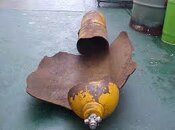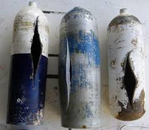This followed the "exploding tank article: There were a series of AL tanks produced by a couple of manufacturers prior to 1989 that have proven more likely to explode than others due to the material they were made with. These AL tanks are the only tanks that require the Visual Plus test. Many shops will not fill them at all - even if they pass the visual plus test.
As far as o2 being the cause, o2 in the cylinder would expand in volume the same as air and cause a burst disc to rupture before the tank would explode. Certainly o2 is a more volatile gas when it comes to producing flame. It is why tanks and valves must be o2 cleaned before filling with 100% o2 and/or before partial pressure nitrox fills - which require 100% o2 be put into the cylinder before air.
Again, a tank being filled with 100% o2 is more likely to ignite, start a fire and potentially explode during filling - especially if the valve and/or tank have contaminants in them or in new tanks where the smallest sliver of steel remains lodged in the valve or interior of the tank.
It is no more likely in my opinion that a tank being carried - filled with o2 - simply exploded than a tank with air - unless that tank was overpressurized, left in sunlight or heat all day and the burst disc was changed out. The same scenario in which I could see a tank filled with air exploding. In both cases, it would be a much more likely an event if the AL tank was produced prior to 1989.
---------- Post added January 5th, 2014 at 10:12 PM ----------
-the rest of the statement- During my recent VIP class at DEMA they discussed this case. The diver had filled the tank with a nitrox mix, the tank had the burst valve removed and replaced with a plug and the neck at the valve appeared to be on fire at the time of the explosion. This would have denoted the use of a petroleum product of some time not suited for nitrox and the fill with a nitrox mix under high pressure caused the neck to leak fire and explosion followed. That is what I understood the offical report to have said according to the guys teaching hte class.
---------- Post added January 5th, 2014 at 10:36 PM ----------
The tank that caused the damage was steel. The picture I provided to show what that tank may have looked like after the explosion is Al. I posted at wasn't the same tank, what's you point? My point was to show those that don't know the power of a scuba tank.
Ummm no the tank was a CO2 paintball tank - b series with no burst disk just a solid screw. It was an incident in Atlanta in 2010.
Nice try.
DOT lists a HANDFUL of scuba tank ruptures- other than a defective batch of Brazilian aluminum tanks in the late 80's (13 that had metal failure in the neck area) EVERY incident involved a tank that was aluminum and either: out of hydro, no VIP & overfilled, had a tampered-with burst disk, or a defective valve & pure O2.
Any steel tanks? Nope.
Dan-O






